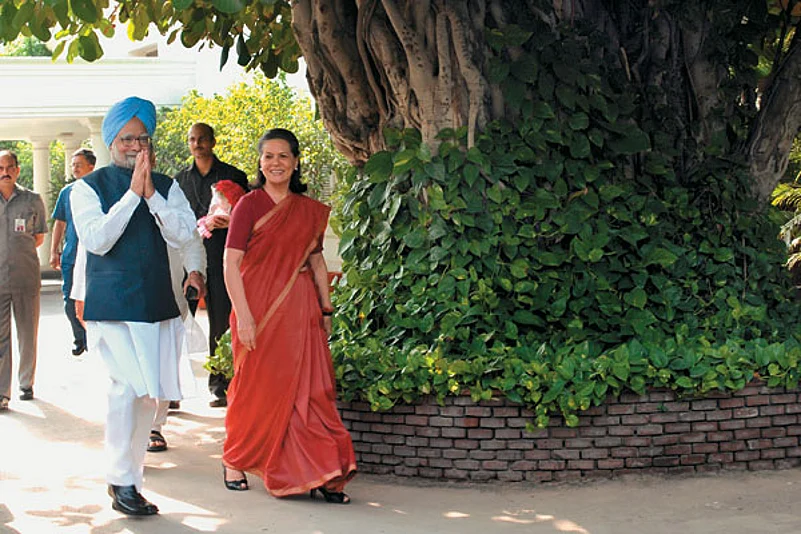If there’s one class of people that knows pretty well how the government is performing, it’s the all-powerful bureaucrats. The babu perspective is particularly crucial in gauging a confusing first year for UPA-II, one that has seen a supercharged PMO asserting itself on key reforms on the one hand, and battling high inflation, pressure from coalition partners and a sense of disconnect with the Congress on the other. That’s why Outlook commissioned research agency MDRA to tap into the bureaucrats’ take. And the verdict on UPA-II’s first year—at 6/10—is upbeat but far from outstanding. Ally ministers—Sharad Pawar, A. Raja and Mamata Banerjee—score low on performance. In fact, pressure from allies is listed as the biggest obstacle to UPA-IIs performance, and inflation its biggest failure. Despite this, a whopping 90 per cent said Manmohan Singh would complete his second stint as prime minister.
| UPA II | |
| How would you rate the performance of the UPA-II government at the end of its first year? (1 means “extremely poor” and 10 “extremely good”) | |
| Score | Per cent |
| 10 | 02.2 |
| 09 | 01.6 |
| 08 | 08.2 |
| 07 | 23.5 |
| 06 | 30.1 |
| 05 | 18.6 |
| 04 | 09.8 |
| 03 | 02.2 |
| 02 | 00.5 |
| 01 | 03.3 |
| Median Score | 6/10 |
| Which is the biggest success in the first year of UPA-II? | |
| Right to Education | 28.4 |
| Women’s Reservation Bill | 25.1 |
| Managing economic growth | 23.0 |
| Foreign policy | 06.0 |
| Fighting inflation | 02.7 |
| NREGA | 01.6 |
| Sustainability of economic growth | 01.1 |
| Others | 01.2 |
| None | 10.9 |
| Which is the biggest failure of UPA-II? | |
| Corruption | 16.9 |
| Inflation, price rise | 62.3 |
| Farmer suicides | 05.5 |
| Ministerial gaffes | 02.7 |
| Sellout to corporates | 02.2 |
| Lack of internal security | 02.2 |
| Maoist problems | 01.6 |
| Women’s Reservation Bill | 01.1 |
| Others | 05.2 |
| None | 00.5 |
| Will Manmohan Singh complete his second stint as PM? | |
| Yes | 90.7 |
| No | 02.7 |
| Can't say | 06.6 |
| Has UPA-II performed better or worse without Left support? | |
| Better | 63.4 |
| Same | 24.6 |
| Can’t say | 02.2 |
| Worse | 09.8 |
| Will Sonia Gandhi's return as National Advisory Council chief help UPA-II? | |
| Yes | 71.6 |
| No | 19.1 |
| Can't say | 09.3 |
| If an election is held tomorrow, will you vote for UPA? | |
| Yes | 57.4 |
| No | 12.0 |
| Can't say | 12.6 |
| Maybe | 18.0 |
| What has been the biggest obstacle to better performance in UPA-II? | |
| Pressure of allies | 49.7 |
| Lack of constructive opposition | 21.9 |
| Disconnect between Congress and PM | 14.8 |
| PMO setting agenda of ministries | 08.7 |
| Lack of leadership | 02.2 |
| Lack of policy clarity | 01.2 |
| Lack of commitment | 00.5 |
| Maoist problems | 00.5 |
| Coalition politics | 00.5 |
| Best Ministries | |
| Which ministries have performed the best in the first year of UPA-II? | |
| Home Affairs * | 23.8 |
| Finance | 21.5 |
| HRD | 17.1 |
| Defence | 06.6 |
| External Affairs | 05.8 |
| Commerce & Industry | 05.0 |
| Rural Development | 03.0 |
| Railways | 02.2 |
| Health & Family Welfare | 02.2 |
| Law & Justice | 01.9 |
| * Most of the interviews were conducted before the second Dantewada incident | |
| Worst Ministries | |
| Which ministries have performed the worst in the first year of UPA-II? | |
| Agriculture | 18.0 |
| Telecom | 11.0 |
| External Affairs | 08.7 |
| Home Affairs | 07.0 |
| Railways | 06.7 |
| Finance | 05.9 |
| Consumer, Food, PDS | 04.8 |
| Health & Family Welfare | 03.7 |
| Petroleum & Natural Gas | 03.7 |
| No comments | 03.7 |
| Best Minister | |
| Who is the best minister in UPA-II? | |
| P. Chidambaram | 39.9 |
| Pranab Mukherjee | 26.2 |
| Kapil Sibal | 14.8 |
| A.K. Antony | 03.8 |
| Manmohan Singh | 02.7 |
| S.M. Krishna | 02.7 |
| Anand Sharma | 02.2 |
| Mamata Banerjee | 02.2 |
| Murli Deora | 01.1 |
| None | 01.6 |
| Worst Minister | |
| Who is the worst minister in UPA-II? | |
| Sharad Pawar | 26.8 |
| A. Raja | 24.0 |
| Mamata Banerjee | 07.1 |
| Jairam Ramesh | 05.5 |
| S.M. Krishna | 03.8 |
| Pranab Mukherjee | 03.8 |
| Shashi Tharoor | 03.3 |
| M.K. Azhagiri | 02.2 |
| P. Chidambaram | 02.2 |
| No comments | 08.2 |
Methodology: Between May 16 and 18, 575 senior bureaucrats were approached at their residences; 183 agreed to take our questions. These are all senior officers (deputy secretary and above): about half the sample comprised IAS officers (90), followed by 50 Indian Allied Services officers, 15 from state services, 8 from the IPS, 5 from the IFS and 15 from other services. Also, 86 per cent of the respondents were male officers, and 14 per cent were female.




















